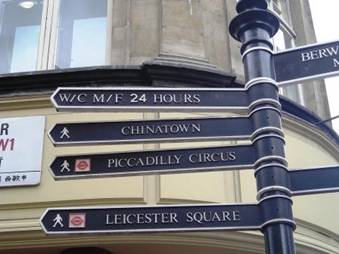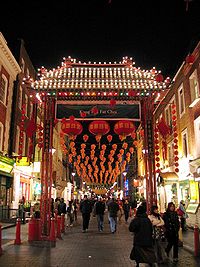
Chinatown is the unofficial name for the area centred around Gerard Street, just below Soho in the three blocks between Leicester Square and Shaftesbury Avenue. Although the tiny ghetto is home to few of London’s 60,000 Chinese population, the area is primarily commercial and remains a focal point for the Chinese community with a number of Chinese restaurants, Chinese supermarkets and souvenir shops

Chinatown's origins date back to the late 18th century when the first Chinese settled in London , having been employed on ships owned by the East India Company. Initially a small community was established around the docks at Limehouse. Following the destruction of the Limehouse area by World War II bombers, the Chinese community migrated to its present location attracted by the low Soho property prices.

During times of Chinese festivity such as the Chinese New Year, the streets are lavishly decorated with flags and lanterns and thousands of Chinese take to the streets amidst dragon and lion dances and loud firecrackers.
Unlike the western calendar, the Chinese New Year falls on a different date each year (the current Year of the Rooster runs from 9th February 2005 to 26th January 2006), and the New Year festivities, which have taken place in London since 1973, occur on the nearest Sunday to Chinese New Year’s Day.
For the rest of the year, the main attraction for Londoners and tourists is the abundance of Chinese restaurants - Chinatown has some of the best and some of the worst in London. A useful tip is that you can suss out the best restaurants by looking for where the Chinese eat, especially during Dim Sum hours at lunchtime.
Today's Chinatown in its own manner is part and parcel of London, yet through its food and cultural events awakened the romantic in each of us. Yet, it is as much a commodity as a splash of colour and a change from the ordinary drill of life.